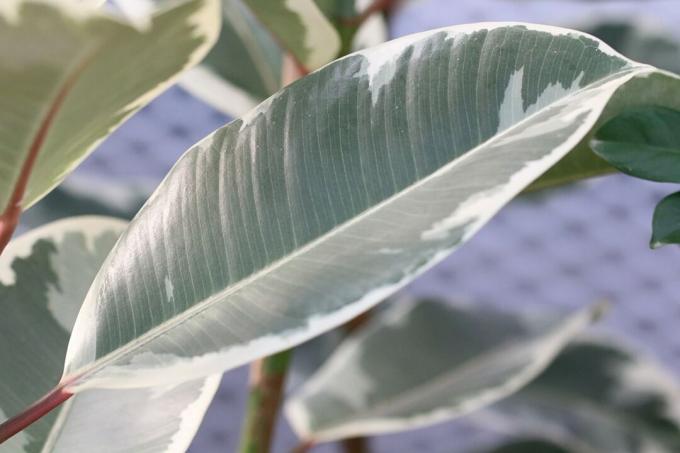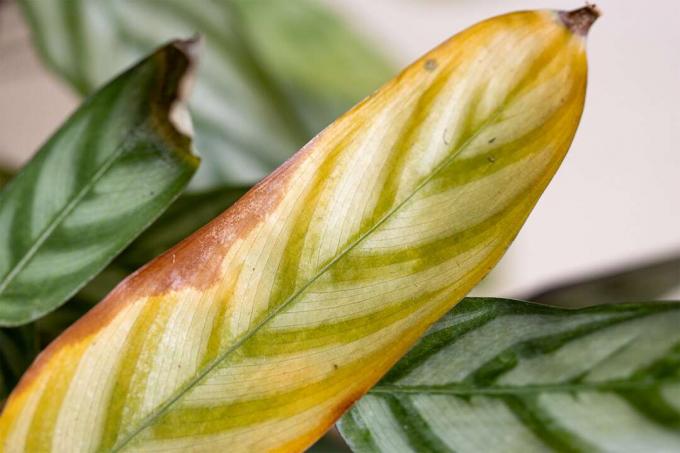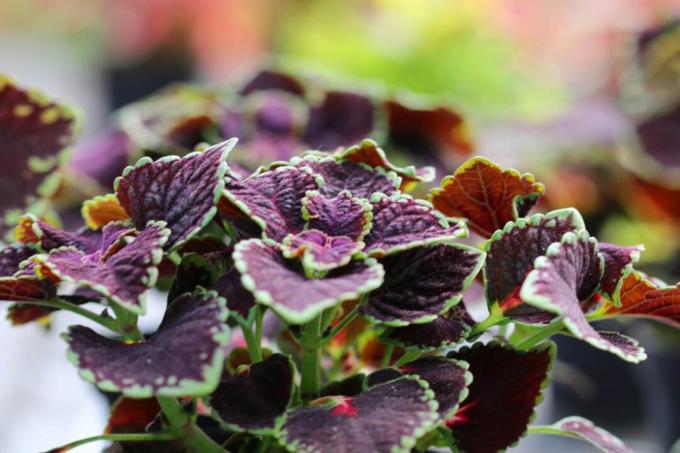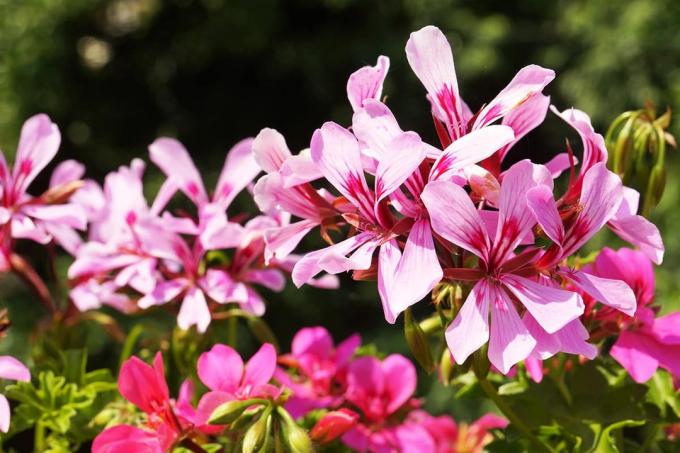

Table of contents
- Characteristics
- Location
- substrate
- repot
- Pour
- Fertilize
- leaf care
- multiply
- Cut
- hibernate
- spider mites
- Mealybug
The rubber tree care is not complex. Ficus elastica, also known under the names Ficus robusta or Ficus tineke, is a robust and undemanding plant whose health depends heavily on the location.
Characteristics
- Plant family: Mulberry family (Moraceae)
- Genus: Figs (ficus)
- Synonyms: Indian rubber tree
- Origin: Northern East India to Indonesia
- Growth form: tree, evergreen, develops long aerial roots, semi-epiphyte
- Original growth height: 2,000 cm to 6,000 cm
- Growth height when kept in tubs: 100 cm to 300 cm
- Flowers: inconspicuous, are formed in the inflorescence, 10 mm in size, monoecious
- Leaves: 8 cm to 45 cm long, leathery, entire, dark green above, light green below
- Fruit: is pollinated exclusively by fig wasps (Agaonidae), no fruiting possible outside the homeland, inedible
Location
In Central Europe, rubber trees are primarily cultivated as a container plant because it gets far too cold for them outdoors. In order to maintain the vitality of Ficus robusta, the right location is essential and should be as follows:
- Light requirement: bright to semi-shady
- avoid direct sun
- at least 18°C
- not too hot
- protect against drafts
Note that rubber trees require warm temperatures year-round. For this reason, you must choose a spot that does not get drafts in winter, as the cool air is a problem for the ficus.

Tip:
If you want to move the fig tree outside over the summer, that is not a problem. Make sure that the temperatures do not fall below 15°C, otherwise the rubber tree will get too cold.
substrate
Rubber trees are planted in sufficiently large tubs including drainage holes. They are important to prevent waterlogging, which can lead to major problems when caring for rubber trees. The pots are ideally filled with the following substrate:
- Houseplant, green plant or compost soil
- Work in coconut or wood fibers
- create drainage
- Drainage material: gravel, potsherds, perlite
repot
Another part of rubber tree care is repotting. Moving to fresh substrate is important for Ficus robusta when the entire pot is rooted. The following guide will help you:
- Carefully remove the plant from the container
- Remove soil from root ball
- cut off dried, dead or rotten roots
- prepare new pot
- Don't forget the drainage layer
- insert plant
- fill with substrate
- moisten well
- Gently press down on the soil
Pour
It is not difficult to water the ficus. Rubber trees receive water as needed, otherwise they quickly become too wet. Waterlogging, in turn, can lead to various diseases that would seriously damage the rubber tree. Therefore, always first check the substrate for dryness using a finger test. When the first layer has dried slightly, water. Since rubber trees are sensitive to lime, you must use the following water variants when watering:
- filter water
- stale tap water
- rainwater
A notice:
If the leaves of the Ficus robusta suddenly fall off, you have to repot the plant due to waterlogging. As you do this, remove any rotten roots to allow the fig to recover.
Fertilize

Rubber trees are fertilized from spring to the end of summer. As soon as autumn comes, there is no more fertilization. Use a high-quality green plant fertilizer and add it to the irrigation water every two weeks. Never fertilize the Ficus elastica over the leaves. Otherwise, burns will occur, which will have a negative effect on the health of the plant.
A notice:
If the leaves turn yellow and wither within a short time, the fig suffers from chlorosis. The cause is a magnesium deficiency, which you have to compensate for by adding appropriate nutrients.
leaf care
The rubber tree and its varieties form very large leaves. This often leads to a layer of dust forming on them. Not only is it unsightly, it also has a negative effect on absorbing moisture from the air. For this reason, you should clean the leaves at regular intervals. To do this, the entire plant is wiped with a damp cloth and then placed in the shower. The bucket is wrapped in foil so that no moisture gets into the soil, since the shower water could contain lime. Rinse the plant well and let it drain so that the substrate does not get too wet. To prevent another layer of dust, spray the leaves with lime-free water every week.
multiply
Ficus elastica is ideally propagated by cuttings. Head cuttings are the much simpler method, since propagation from seeds cannot always be guaranteed. For head cuttings, cut off shoots on the rubber tree that are five to ten centimeters long. Then remove all leaves on the lower half, as this part is needed for rooting. There must be at least one leaf and one bud on the head cutting for propagation to succeed. The following points explain how to proceed:
- Moisten head cuttings with willow water
- alternatively use root activators
- Prepare seed pots
- use nutrient-poor potting soil
- Insert cuttings into the substrate
- Half should look out of the ground
- moisten with water
- Water must be lime-free
- cover with transparent film
- alternatively place in a mini greenhouse
- choose warm and bright spot
- Check the substrate regularly and moisten if necessary
- air regularly
- new shoots indicate rooting
- usually lasts eight to twelve weeks
- then remove the foil
- The young plant must root through the nursery pot
- can take three to five months
- then repot and care for as usual
Cut
Regular pruning is not necessary when caring for Ficus elastica. It is particularly suitable for young plants that are supposed to grow even more extensively. If your rubber tree is too tall, you can also shorten it without any problems. In order to make the cut as effectively as possible, timing is important:
- end of winter
- beginning of spring
At this time, not so much milky juice is formed, which facilitates the pruning measures. Be sure to wear gloves when cutting if you have a latex allergy. The escaping milky juice can immediately lead to allergic reactions on contact. The milky juice even has an irritating effect on the skin of non-allergy sufferers. You should also protect the floor with painter's film or newspaper. The milky sap can lead to discolouration on surfaces that can no longer be removed. The same applies to clothing. Don't wear your best wardrobe for the cut. The following guide covers the most important steps:
- Disinfect and sharpen secateurs
- If the Ficus is too large, shorten the main shoots to the desired height
- always cut over a sheet
- Shorten side shoots
- always keep the natural form
- Then burn off cuts with a flue
- alternatively rub with ash
- stops wound discharge
Tip:
Do not dispose of clippings if they are still healthy. You can use it as a cutting for propagation.
hibernate

Since Ficus elastica is a tropical plant, you must protect the plant from the winter temperatures. Fortunately, the trees can remain in their original location as long as the thermometer does not drop below 15°C there. The plants are also watered as required, while all nutrient additions are completely stopped. Don't forget to keep the humidity high enough. If it is too dry, the risk of diseases caused by pests increases.
spider mites
Although the rubber tree is resistant to diseases, pests can rarely settle on the fig. Especially over the winter, animals can be expected to feast on the juicy leaves. If there is prolonged drought during the cold season, you must expect a spider mite infestation, which can be recognized by the following symptoms:
- leaves weaken
- Webs visible between the leaf axils
- lice visible
If nothing is done about the arachnids, Ficus elastica will become weaker and weaker and may even die. An infestation is prevented by the necessary humidity, as the plant is much better armed against the insects. Isolate the affected plant and spray the plant with enough lime-free water to remove most of the spider mites. The rubber tree is then wrapped in a transparent film. The humidity below drives away the spider mites until you get rid of the plague.
Mealybug
Not only spider mites stay on rubber trees. If you recognize the following symptoms, you are dealing with mealybugs:
- Mealybugs recognizable
- wool-like deposits visible on the underside of the leaves
- leaves wither
- entire plant weakens
Mealybugs pose a major threat to rubber trees, as they can kill the entire tree. For this reason, fight the lice as soon as possible so that your Ficus tineke does not die. This works as follows:
- Isolate the plant - this will limit the spread of mealybugs
- Make a spray from 3 tablespoons of olive or rapeseed oil, a little washing-up liquid and 500 ml
- fill in spray bottle - use daily until all lice are gone
- Repot the plant thoroughly
- Check root ball for lice, eggs and dead roots - remove these
- Plant rubber tree in fresh substrate
- Optimize location and care measures to prevent further diseases caused by pests
 garden editorial
garden editorial I write about everything that interests me in my garden.
Learn more about houseplants

Calathea has yellow leaves: how to save?
When a Coriander (Calathea) gets yellow leaves, the cause is usually a lack of care. In order to save them from dying, a number of countermeasures must be taken, which are described in detail here.

Room bamboo: 13 tips for care
The room bamboo impresses with its compact growth habit and is a densely grown houseplant. The ten most important tips for caring for the sweet grass are compiled for you here.

Coleus blumei: 21 tips for the red nettle
The colored nettle is a warmth-loving and easy-care foliage plant. The coloring of the leaves varies from monochromatic to variegated with a wide variety of drawings. Spectacular splashes of color can be set in beds, balcony boxes and tubs or as a houseplant.

Scented houseplants: 25 scented plants for the home
An apartment without indoor plants is hardly conceivable. Scented plants in particular have a very special effect. Not only are they decorative, they can lighten the mood and rival any artificial home fragrance.

Lucky chestnut, Pachira aquatica: care from A to Z
The care of the lucky chestnut does not require any special expertise. However, if you know the way of life of this ornamental plant, you can better adapt site conditions and care measures to your needs. The plant can be easily propagated if a plant already exists.

Ray Aralia, Schefflera: care from A to Z
Schefflera arboricola delights hobby gardeners with lush growth in suitable locations. It has hardly any special requirements and proves to be extremely easy to care for. Beginners will have a lot of fun with this plant because it forgives minor care mistakes and is adaptable.



